By now it seems that most people on the planet have heard of Apple’s latest iPhone, the iPhone 4 which was released today. One of the many compelling features of the new phone is the Retina Display. When Steve Jobs first invoked this term at the WWDC, my eyebrows were raised. Being a retinal scientist, I was immediately skeptical of just what he meant by “retinal display”. My mind immediately raced and I wondered if it might have been some of the interesting technology I got to see on my last visit to one of Apple’s technology development labs. I will not say anything about that visit, but this Retina Display, a super high resolution display was new technology that I had not seen before. Essentially it is an LED backlit LCD display with a *326* pixel per inch (960×640) display (John Gruber of Daring Fireball called this resolution display back in March) where each pixel measures a scant 78μm. Though as you can see from these images of the displays I captured under a microscope, these pixels are not square. Rather they are rectangular and while the short axis is 78μm, the long axis on the iPhone 4 pixel is somewhere in the neighborhood of 102μm. Update 07/23/10: After discussion with some folks, including an LCD engineer, they have pointed out that pixels are measured from center to center rather than edge to edge, so I have changed the scale bars to reflect new measurements with a micrometer. Additionally, others have emailed me noting that if the black space surrounding the pixels is taken into account, the pixels are in fact, square. So, the measurement of 78μm for the iPhone 4 is in fact 78μm from center to center of every pixel. Also, Ron Uebershaer sent in screenshots I’ve included at the bottom of this post that he made in MATLAB which conceptually demonstrate that the pixels are in fact square.
I am including images below of the iPhone 1G, the iPhone 3G, the iPhone 4G and the iPad to show some perspective on pixel sizes. The scale bar and my measurements are approximate as I was having a tough time in the lab tonight finding an appropriate calibration. Nevertheless, this should serve as a useful metric for examining the relative pixel sizes and for making the point of whether Apple’s Retina Display is marketing speak and hyperbole or if in fact, Apple’s claims have merit.
As you can see from this image, the iPhone 1G pixels (each composed of a red, green and blue sub-pixel) measure approximately 150μm x 500μm. Also note the blurryness of the image. This was optimally focused, but the LCD panel itself is behind a non-bonded pane of glass with touch sensor on it leading to some image degradation.
As in the 1G iPhone, the iPhone 3G pixels are essentially the same size, though with a different contact location. Again, these pixels measure approximately 150μm x 150μm and this LCD display has the same blurring issues that are present in the iPhone 1G.
This image of the iPhone 4G LCD is made at the same magnification as the 1G and 3G iPhones illustrating the substantially smaller pixel size in the iPhone 4G. These pixels are remarkably small and if you look carefully, appear to be composites themselves where each sub-pixel is composed of its own sub-pixels. I am not sure about this however and it may simply be an artifact of the construction. Also note that there is very little distortion in the pixel images as the iPhone 4G has a bonded glass cover, eliminating the space in between the LCD panel and the touch sensitive glass surface.
iPhone1: ~150 x 150μm
iPhone 3G: ~150μm x 150μm
iPhone 4G: ~78μm x 78μm
So… the claim from Steve was that this display had pixels that matched the resolution display of the human retina. Now, fan of Apple that I am, this struck me as perhaps a bit hyperbolic, so I figured I’d do some quick calculations to see where this claim fell. Apparently I am not the first Ph.D. to wonder as another came out calling the bluff of Mr. Jobs. Here is the deal though… While Dr. Soneira was partially correct with respect to the retina, Apple’s Retina Display adequately represents the resolution at which images fall upon our retina.
Essentially, this is a claim of visual acuity which is the ability of the visual system to resolve fine detail. There are an awful lot of considerations to take into account when making such a claim such as contrast, distance, the resolution of the display and some metric of pixel size which gives you an estimate of visual resolution on the retina. Claims of contrast ratios are notoriously flexible in a number of displays and will be influenced by a number of optical factors as well as the content being viewed and the black and color levels of the pixels as well as overall luminance. Apple claims an 800:1 pixel ratio and I’ll take them at their word on that and focus on the claims of resolution here.
A “normal” human eye is considered to have standard visual acuity or 20/20 vision. This means that a 20/20 eye can discriminate two lines or two pixels separated by 1 arcminute (1/60 degree).
The ability of an optical system to resolve fine detail requires minute spacing of optical detectors. In the retina, there detectors are the photoreceptors. Objects we look at at projected through the cornea and lens and imaged on the back of the eye on a plane that ideally lines up with the retinal photoreceptors.
Theoretically the limit of retinal resolution, say the ability to distinguish patterns of alternating black and white lines is approximately 120pixels/degree in an optimal, healthy eye with no optical abnormalities. Again, this corresponds to one minute of arc or 0.000291 radians (π/(60*180)). If one assumes that the nominal focal length of the eye is approximately 16mm, an optimal distance from the eye for viewing detail might be around 12 inches away from the eye which is reasonable to assume for someone viewing detail on their iPhone.
Dr. Soneira’s claims are based upon a retinal calculation of .5 arcminutes which to my reading of the literature is too low. According to a relatively recent, but authoritative study of photoreceptor density in the human retina (Curcio, C.A., K.R. Sloan, R.E. Kalina and A.E. Hendrickson 1990 Human photoreceptor topography. J. Comp. Neurol. 292:497-523.), peak cone density in the human averages 199,000 cones/mm2 with a range of 100,000 to 324,000. Dr. Curcio et. al. calculated 77 cycles/degree or .78 arcminutes/cycle of *retinal* resolution. However, this does not take into account the optics of the system which degrade image quality somewhat giving a commonly accepted resolution of 1 arcminute/cycle. So, if a normal human eye can discriminate two points separated by 1 arcminute/cycle at a distance of a foot, we should be able to discriminate two points 89 micrometers apart which would work out to about 287 pixels per inch. Since the iPhone 4G display is comfortably higher than that measure at 326 pixels per inch, I’d find Apple’s claims stand up to what the human eye can perceive.
For reference, I am also including an image of the iPad LCD taken at the same magnification as the iPhone images above. As you can see, the pixel size is actually much larger and herringbone shaped which is not uncommon in high quality desktop displays like say, the Apple Cinema Display line.
Update 03/02/11: Carles Mitjá has an entry with a proceedings citation highlighting image quality expectancy here. He has three beautiful images of a MacBook Pro 15″ display, an iPhone 4 display and a very interesting 24″ Apple Cinema Display.
Update 08/24/12: Looks like this article has resulted in my being quoted in the NYTimes for an article on choosing computer displays.
Update 12/15/13: Linked from an NBC News article on 4k televisions, Enough pixels already! TVs, tablets, phones surpass limits of human vision, experts say.
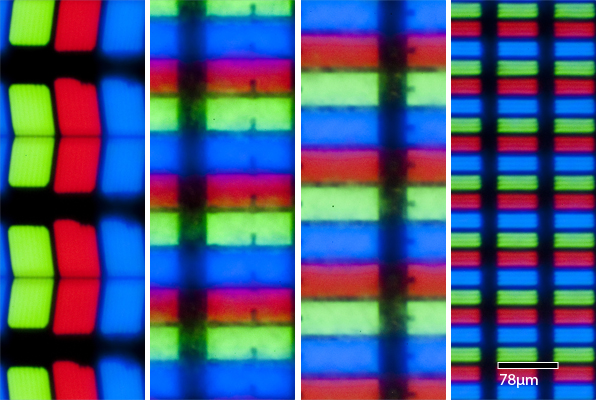
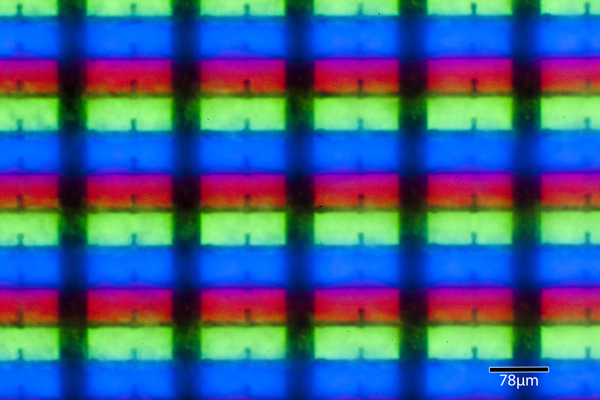
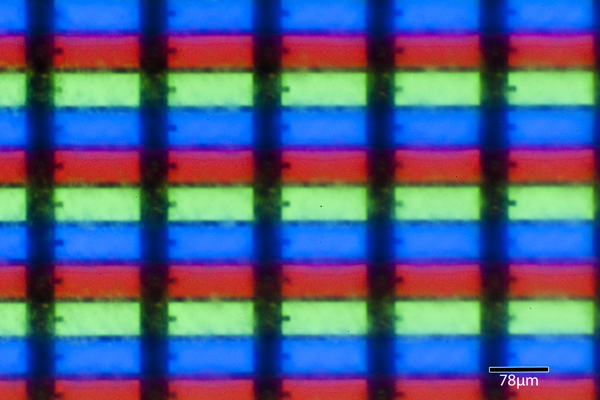
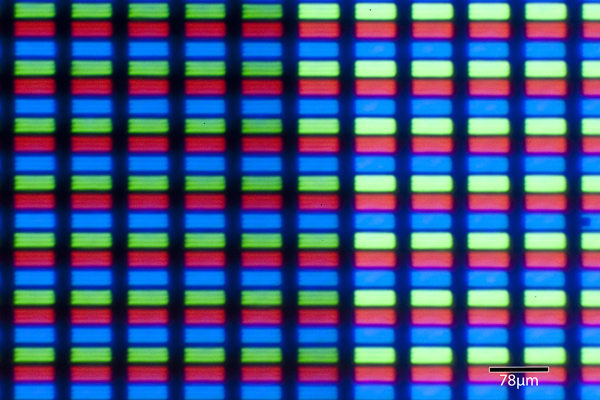
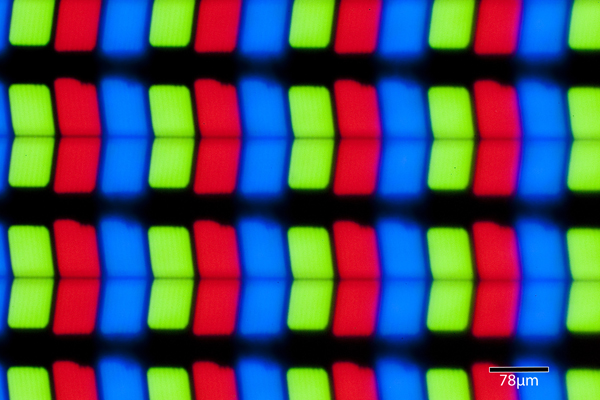
Amazing photos, very interesting article, thanks for posting it !
thank you so much for such a good article! best of luck to you
Bryan, perhaps can be of your interest our recent work. It can be seen at:
http://cmitja.wordpress.com/2011/03/02/displays-pixel-size/
Best regards, Carles
This is a very good, easy to understand article. I appreciate the effort you put into this.
One thing that strikes me about the entire “retinal display” concept is that it is based, either way upon optimal human eyesight under ideal conditions. In practice, neither of these often happen for human eyes or for displays on phones or computer screens.
Consider how many people must wear glasses or contact lenses, then consider how many should but do not. Under real world conditions, many displayed exceed the capabilities of the average human eye.
Great article – I very much appreciate your work!!!
Does anyone know what the spacing is between the pixels and the top surface of the glass on the iPhone 4S? My tests with a parallax barrier show it is 1.5mm but I would like independent confirmation
Thanks Boyd,
I have no idea what that distance is between the surface of the glass and the pixels, though it can’t possibly be 1.5mm. My guess would be half that number based upon the raw images.
Horizontal or diagonal pixel density?
Interesting statements. One issue, though:
Pixels 89 micrometers apart were considered to work out to about 287 pixels per inch. This, however, is only valid if the vertical/horizontal distance of Pixels is considered only. Since also diagonal lines should not be discriminated as rows of pixels, isn’t it necessary to rather consider the larger diagonal distance of pixels?
If so, for a diagonal distance of 89 micrometers, displays exceeding 400 ppi horizontal/vertikal pixel densities are required instead of 287 ppi.
After looking through this article, I was able to get a lot of information about the displays. 78 micrometers of width is such an achievement that when you look at the iphone or the latest ipad, you will be amazed at the clarity.
Although AMOLED screens have come up with proper black levels and capability to go high resolution, they are still no match for Retina display. In my article Comparing Retina display and AMOLED, I have given a detailed comparison of these two technologies
Nice article. Thanks. It’ll be interesting to see where OLED screens go in the next couple of years. If they can boost the resolution, then they will be the way to go.
What about the Megapixel of a smartphone camera? Does it follow that the higher the MP is, the better the quality of the ppi of the output or the capture? Does the camera capture, depending on the number of megapixels, shows the same ppi seen on a phone screen and a laptop’s monitor? What’s the relation of megapixels to ppi?
I’m just curious.
Hey Nonoy,
Turns out optics are pretty much the most important thing aside from pixels. Some of the best macro photographs I’ve every shot were on an old 8MP DSLR with an amazing Zeiss lens. The number of pixels simply speaking, allows you to make bigger prints with more detail.
Hi Bryan,
I see. Now I understand that it doesn’t matter how big the megapixels in relation to the quality of the capture. The MPs are for printing.
Thanks a lot Bryan. You’re such an expert on this filed. Kudos!